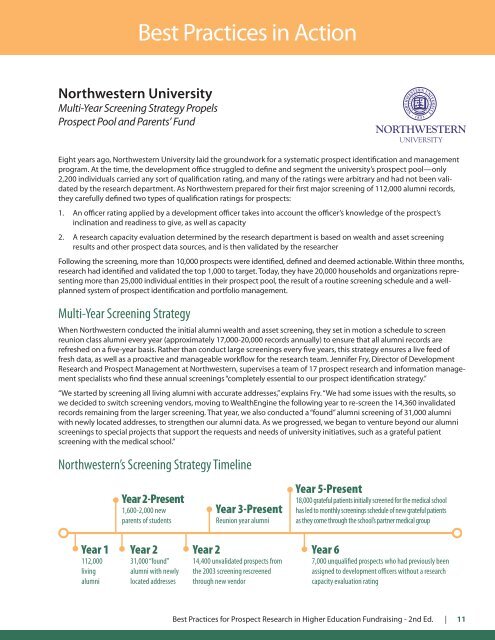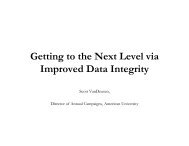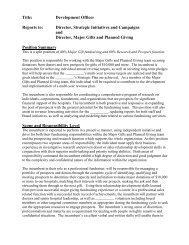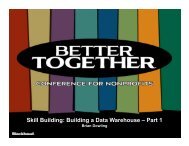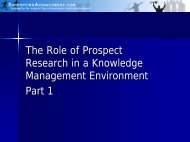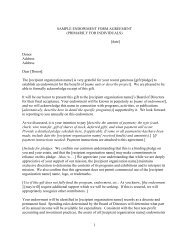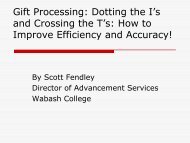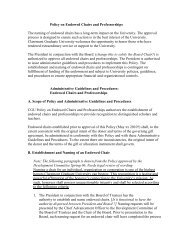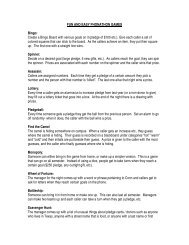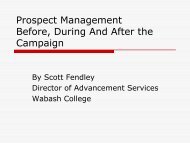WealthEngine Best Practices in Higher Education for Prospect ...
WealthEngine Best Practices in Higher Education for Prospect ...
WealthEngine Best Practices in Higher Education for Prospect ...
Create successful ePaper yourself
Turn your PDF publications into a flip-book with our unique Google optimized e-Paper software.
<strong>Best</strong> <strong>Best</strong> <strong>Practices</strong> <strong>Practices</strong> <strong>in</strong> Action<br />
Northwestern University<br />
Multi-Year Screen<strong>in</strong>g Strategy Propels<br />
<strong>Prospect</strong> Pool and Parents’ Fund<br />
NORTHWESTERN<br />
UNIVERSITY<br />
Eight years ago, Northwestern University laid the groundwork <strong>for</strong> a systematic prospect identification and management<br />
program. At the time, the development office struggled to def<strong>in</strong>e and segment the university’s prospect pool—only<br />
2,200 <strong>in</strong>dividuals carried any sort of qualification rat<strong>in</strong>g, and many of the rat<strong>in</strong>gs were arbitrary and had not been validated<br />
by the research department. As Northwestern prepared <strong>for</strong> their first major screen<strong>in</strong>g of 112,000 alumni records,<br />
they carefully def<strong>in</strong>ed two types of qualification rat<strong>in</strong>gs <strong>for</strong> prospects:<br />
1. An officer rat<strong>in</strong>g applied by a development officer takes <strong>in</strong>to account the officer’s knowledge of the prospect’s<br />
<strong>in</strong>cl<strong>in</strong>ation and read<strong>in</strong>ess to give, as well as capacity<br />
2. A research capacity evaluation determ<strong>in</strong>ed by the research department is based on wealth and asset screen<strong>in</strong>g<br />
results and other prospect data sources, and is then validated by the researcher<br />
Follow<strong>in</strong>g the screen<strong>in</strong>g, more than 10,000 prospects were identified, def<strong>in</strong>ed and deemed actionable. With<strong>in</strong> three months,<br />
research had identified and validated the top 1,000 to target. Today, they have 20,000 households and organizations represent<strong>in</strong>g<br />
more than 25,000 <strong>in</strong>dividual entities <strong>in</strong> their prospect pool, the result of a rout<strong>in</strong>e screen<strong>in</strong>g schedule and a wellplanned<br />
system of prospect identification and portfolio management.<br />
Multi-Year Screen<strong>in</strong>g Strategy<br />
When Northwestern conducted the <strong>in</strong>itial alumni wealth and asset screen<strong>in</strong>g, they set <strong>in</strong> motion a schedule to screen<br />
reunion class alumni every year (approximately 17,000-20,000 records annually) to ensure that all alumni records are<br />
refreshed on a five-year basis. Rather than conduct large screen<strong>in</strong>gs every five years, this strategy ensures a live feed of<br />
fresh data, as well as a proactive and manageable workflow <strong>for</strong> the research team. Jennifer Fry, Director of Development<br />
Research and <strong>Prospect</strong> Management at Northwestern, supervises a team of 17 prospect research and <strong>in</strong><strong>for</strong>mation management<br />
specialists who f<strong>in</strong>d these annual screen<strong>in</strong>gs “completely essential to our prospect identification strategy.”<br />
“We started by screen<strong>in</strong>g all liv<strong>in</strong>g alumni with accurate addresses,” expla<strong>in</strong>s Fry. “We had some issues with the results, so<br />
we decided to switch screen<strong>in</strong>g vendors, mov<strong>in</strong>g to <strong>WealthEng<strong>in</strong>e</strong> the follow<strong>in</strong>g year to re-screen the 14,360 <strong>in</strong>validated<br />
records rema<strong>in</strong><strong>in</strong>g from the larger screen<strong>in</strong>g. That year, we also conducted a “found” alumni screen<strong>in</strong>g of 31,000 alumni<br />
with newly located addresses, to strengthen our alumni data. As we progressed, we began to venture beyond our alumni<br />
screen<strong>in</strong>gs to special projects that support the requests and needs of university <strong>in</strong>itiatives, such as a grateful patient<br />
screen<strong>in</strong>g with the medical school.”<br />
Northwestern’s Screen<strong>in</strong>g Strategy Timel<strong>in</strong>e<br />
Year 2-Present<br />
1,600-2,000 new<br />
parents of students<br />
Year 3-Present<br />
Reunion year alumni<br />
Year 5-Present<br />
18,000 grateful patients <strong>in</strong>itially screened <strong>for</strong> the medical school<br />
has led to monthly screen<strong>in</strong>gs schedule of new grateful patients<br />
as they come through the school’s partner medical group<br />
Year 1<br />
112,000<br />
liv<strong>in</strong>g<br />
alumni<br />
Year 2<br />
31,000 “found”<br />
alumni with newly<br />
located addresses<br />
Year 2<br />
14,400 unvalidated prospects from<br />
the 2003 screen<strong>in</strong>g rescreened<br />
through new vendor<br />
Year 6<br />
7,000 unqualified prospects who had previously been<br />
assigned to development officers without a research<br />
capacity evaluation rat<strong>in</strong>g<br />
<strong>Best</strong> <strong>Practices</strong> <strong>for</strong> <strong>Prospect</strong> Research <strong>in</strong> <strong>Higher</strong> <strong>Education</strong> Fundrais<strong>in</strong>g - 2nd Ed. | 11


